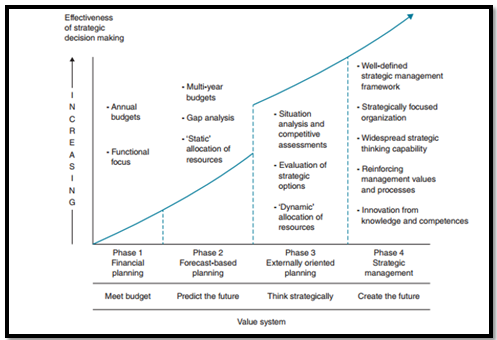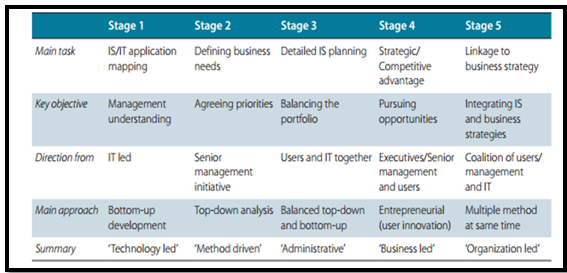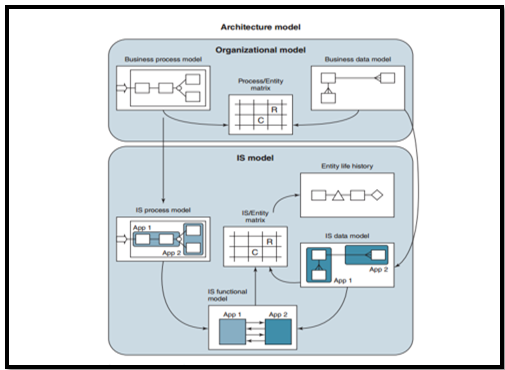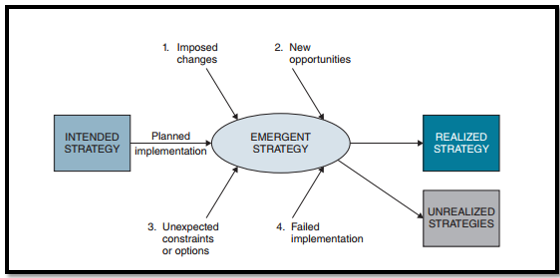Information system strategy assignment: Importance of IS/IT in Organizations
Question
Task:
Most organisation in all sectors of industry, commerce, not-for-profit, and government are now dependent on IS and IT strategy. Why is IS/TT strategy important to organisations? And without good IS/IT strategy, how would this impact organisation?
Students need to select a topic within the area of
Business and IT and write a research case study
report.
You need to investigate the topic selected and provide detailed discussions using literature research,
relevant examples of companies, key concepts, and evidence to support your discussion. You are
also required to include a Table of Content, introduction, conclusion, and a full reference list.
Answer
Introduction
The present information system strategy assignment is examining the role of the information systems and technologies within the organisations, government, non-profit or commerce that is gradually evolving. IT/IS currently being appreciated in the boardrooms rather than being demoted to the behind the scenes role-play of the organisations. It is thus expected to play a vital role regarding the delivery of the high-end value along with the transformation of the industries. With the current technology becoming so much important regarding the delivery and development of the business strategy of the organisations, more and more focus needs to be given to the development of the information strategy than it has been developed in the past.
This report on information system strategy assignment will focus on the importance of IS/IT strategy in the organisations with the help of examples and shreds of evidence to explore how the organisations are functioning towards the improvement of the strategy development and implementation regarding IS/IT. This information system strategy assignment will show that the evolving nature of the strategic management in the organisations will lead to the evolution of IS/IT strategy processes. The development of the effective process to establish IS/IT strategy will be discussed along with the role of the Business Operating Model. The factors to impact the process of business innovation with IS/IT will be analysed, along with strategic implications of IS/IT. The impact it will have on the organisations without IS/IT strategy will also be evaluated in the information system strategy assignment.
Concept of IS/IT strategy
Herein information system strategy assignment, an IS/IT strategy is being identified as a document of planning that helps to explain how information systems and technology should be used as a portion of the overall strategy of the business of the organisations (De Haes et al. 2020). This strategy should be designed to support the overall plan of business of an organisation. IS/IT strategy can be defined as the activities that are directed towards indicating the opportunities of the organisations to determine the requirements of the resource. Thus the IS/IT strategies help to develop the action plans to realize such opportunities and meet the needs of the resources.
Evolving nature of strategic management in organisations
As per the research on information system strategy assignment, in the mid-1970s, there arose an urgent need regarding resolving the problems of the organisations in the post-industrial era with the help of effective strategic planning. The concept of strategic management was developed to include the formal planning in the development of IS/IT strategy (Durand, Grant and Madsen 2017). The evolution of strategic management in organisations can be described through a model.
As discussed in the information system strategy assignment, in phase 1, the main focus is on the financial annual planning and the flow of cash to develop the medium-term budgets, and is thus consolidated. In phase 2, the focus is on prediction on the analysis of historical performance and the projections of the future using the market research data. In phase 3, the organisation tries to achieve an effective understanding of the competitive nature of the industry to assess its position to gain an advantage. In the final phase, the organisation is mainly driven by innovation to become capable of developing its own organisational environment (Kohli and Melville 2019).

Figure 1: Evolving nature of strategic management in the organisations
(Source: Webster and Ivanov 2020)
Evolution of IS/IT strategy process
A maturity model regarding the IS/IT or digital strategy is being developed in this context of information system strategy assignment that helps to reflect the evolutionary journey present in different organisations (Zhang, Chen and Luo 2018). The strategy can also be developed through multiple iterations. Such evolutionary processes help in achieving the result related to the value creation of the superior business. The evolutionary stages are
In the first stage, the IT organisations help to plan the interfaces regarding the development of applications in a separate manner to function efficiently in the usage of technology. In the second stage outlined herein information system strategy assignment, the management develops a top-down review regarding IS/IT applications based on business needs and priorities. The third stage is revolving around IS/IT planning to determine the best way regarding the implementation of the existing systems in an affordable and integrated manner. The last stage shows that the business users of systems, information and technology use ARE/IT strategy in a new way to develop a competitive advantage (Grover et al 2018).

Figure 2: Evolution of IS/IT strategy process
(Source: Webster and Ivanov 2020)
Developing an effective process for establishing IS/IT or digital strategies
There is no such process to formulate the IS/IT strategy that can guarantee success in the organisations. However, a proactive search helps to determine the competitive advantage in the organisations through the application of information and the use of technology. Thus an effective process needs to be developed to incorporate a wide variety of digital technologies regarding processing data, delivering communication and information (Wilberg et al 2017). The process noted in the information system strategy assignment includes
Developing the strategy cycle: The organisations need to develop the decisions related to strategy cycle to continue the process of the development of IS/IT strategy. The governance structure or mechanism will be responsible for the supervision of those activities.
Assessment of the modern environment of the organisation: The modern organisational environment and the related issues need to be identified at the initiation stage to develop the activities related to IS/IT strategy.
Development of objectives for the IS/IT strategy: The objectives related to the planning and the development of the strategy of IS/IT are initially derived from the business drivers and objectives for change.
Developing criteria for success: The success criteria are measured with the help of two aspects, like the degree of success of the strategy process and the extent of the resulting strategy to be successful.
Business operating Model
The business operating model related to IS/IT strategy developed in the information system strategy assignment consists of the business processes, activities and key entities (Metallo et al 2018).
Processes: The interlinked activities to deliver the specific outputs to the specific customers within the organisation.
Activities: The business process elements to promote and distribute the products and services to measure performance.
Key entities: They may include the customers, assets, places and events.
This operating model helps to develop the programs and the projects to create the strategies through the new or redesigning the current processes, besides developing new assets related to IT/IS. Thus the standardization is needed for the effective planning of the IS/IT strategy. The advantages offered by standardization include the reduction of costs, simplification of the operations, increase in efficiency and the development of the platform for innovation. The operating model of the organisations mentioned in the information system strategy assignment is primarily the output of the legacy decisions regarding the investments of IS/IT to develop the structure. Thus the business operating model is being identified as a valuable technique regarding the development of strategy development of IS/IT (Schallmo, Williams and Boardman 2017). If the business is considering the development of the IS/IT strategies, it surely achieves a large understanding of the organisation which is essential to recognize the capabilities of the organisation. It can be said in the information system strategy assignment that the business operating model helps in the planning activities and the development of strategies related to the IS/IT that helps in the new investments in the long run.

Figure 3: Business Operating Model
(Source: Metallo et al. 2018)
What are the factors impacting the process of business innovation with IS/IT discussed within the information system strategy assignment?
There are important factors that help to impact the process of business innovation with IS/IT. They are noted below within the information system strategy assignment
The strategic context of the firm: The role of information and IS/IT in the development of the strategy is being identified as an important determinant regarding the extent of innovation in any organisation (Drechsler and Weibschädel 2018). The important choice that most of the organisations face is whether to become an early adopter to achieve innovative success. They have to consider whether the IS/IT strategy as the source of administrative expense or competitive differentiation can be reduced. Influences of the industry: There exists a range of discussions conducting at any period in any industry. The discussion on information system strategy assignment revolves around the planning of IS/IT strategy, along with the challenges it poses in the businesses. The IS/IT managers have become very much sceptical about the increased generation of the new technologies, and thus they are adopting a cautious step to implement the IS/IT strategy.
Influence of the organisations: The organisations can develop the activity of business innovation with the help of the top management to make an impact on the resources available in support of IS/IT innovation.
The relationship between the reputation of the IS/IT units and the business team affect the innovation process. Besides the organisational culture help to influence the extent of innovation through the outsourcing of IS/IT.
Importance of IS/IT strategy in the organisations
The investigation on information system strategy assignment mentions that the strategy of IS/IT is important for the organisations regarding achieving and sustaining advantages around the value-based disciplines. The IS/IT strategy helps the organisations to achieve success based on the chosen value discipline, like the operational excellence, service/product leadership and customer intimacy. These are the disciplines where the organisations achieve an advantage, besides maintaining parity with their competitors in the other sectors. For example, the bank of Queensland in Australia has developed an excellent home loan portfolio for younger home buyers and has great customer relationships. But the bank did not understand the reason behind the poor sales of the new product. The reason that has been found in the present context of information system strategy assignment was the unreliability and slowness of the current application process of mortgage that the bank was using. Later through the development of the IS/IT strategy, they chose Finnone to promote the flexibility and functionality of the new product (Ibsintelligence.com 2020). Thus the target group of customers are being able to receive the services and the products more efficiently.
Again, Amazon is being able to evaluate the patterns of purchase of the customers through the establishment of IS/IT strategy. Thus, in the information system strategy assignment, they have identified the products that seem to be of great interest for the specific customers and developed personal relationships with them. The company have combined the 1-click purchasing with the business process to make the actual process of buying very convenient. They have developed the cloud-first policy for the effective streamline of the projects (Aws.amazon.com 2020). The importance of IS/IT strategies in the organisations also lies in the exploration of the new value propositions regarding information services and products. Informating is being linked with the addition of value to the current services and products, along with the increased change in the value proposition that is offered to the customers through the collection of information. The development in the technologies related to sensor, communications, miniaturization and the large improvements in the performance of IS/IT has enhanced the opportunities for the organisations to conduct their operations effectively and efficiently. Such development has taken place due to the promotion of informating products. The manufacturing organisations are shifting from selling the products to the provision of services through the strategy of servitization. For example, Rolls Royce derives the information on the health of its engines in real-time to ensure the availability of the engines to the companies. This is being done through the use of enterprise resource planning and cloud with the help of HR team to ascertain the integrity of the organisation, besides ensuring that the service is in continuation to be available to the companies as and when required (Computerweekly.com 2020).
The importance of IS/IT strategy in the organisations illustrated in the information system strategy assignment also lie in informating products to improve the reliability and the availability in use. The reliability and the availability of a product may vary based on the level of technological maturity of the design, besides the manufacturing and the quality of the design. For example, Care of Australia is a non-profit organisation that uses Snapcash to allow the customers to transfer money for the improved care of the orphans, widows and other poor families. It also uses IT for the VSLA model for cost savings and project improvement (Care.org.au 2020). Such service removes the friction to engage in financial transactions, and thus lowers the barriers to entry. Again, the using of diagnostic and prognostic software, along with the use of analytical tools help to avoid the unplanned downtime, loss of output and the high emergency costs of repairing for the organisations. Besides an additional value can be provided to the customers through informating the current products with the help of IS/IT strategy. For example, the smart gas meters and the electricity help to gain access to the controls of central heating that help the organisations to manage the usage of energy, along with the development of the products. In this way, the IS/IT strategy becomes important for organisations.
IS/IT strategy implementation
The IS/IT strategy to be implemented requires a fair amount of resources to be allocated effectively, along with the capabilities to be built or leveraged. It is very much crucial to monitor the activities of control and performance after the implementation of the IS/IT strategy to ensure that the actions are developed and the outcomes are produced (Kitsios and Kamariotou 2017). This helps the organisations to achieve the overall objectives. The measurement of the results performance can be utilized in a loop of feedback to help in the refining of the objectives of the organisations for the realization of the strategies. However, the realised IS/IT strategy is currently performing in the different segments of the market, along with the delivery of the services or the products. The forces can help to impact the planned implementation of IS/IT. The below figure related to the strategy implementation of IS/IT explains the real world where the strategy formulation dependent on the evolving situation or current strategy exists over the formulation of a strategy that generates the intended strategy.

Figure 4: Strategy implementation
(Source: Kitsios and Kamariotou2017)
Impact on the organisations without IS/IT strategy
The organisations who do not use the IS/IT strategy have some impacts on them. The failure of those organisations to carry out the IS/IT strategy can lead to the lost opportunities, incompatibility of the systems, wasted resources and duplicated efforts. The organisations can fail to meet their objectives regarding improving technological use on the lack of implementation of the IS/IT strategy. Besides, the absence of the IS/IT strategy can help the organisations to remain dissatisfied, and they can feel reluctant regarding the continuation of the IS/IT strategies (Yeow, Soh and Hansen 2018). Moreover, it is also clear on this information system strategy assignment that the organisations without the IS/IT strategy can create trouble regarding maintaining and establishing priorities in the future strategies of the IS/IT.
The processes of businesses can lose the need for elimination, streamlining, simplification and redesigning without the significant requirements of the IS/IT. Thus the organisations might not be in a position to deliver the new IS/IT capabilities. The organisations can lack an extended, new and the rationalised resources of information without a good IS/IT strategy. They find it difficult to compare the list of pieces of information with the current databases and systems to determine the origin of new information and new resources. Thus the principal challenge of the organisations can lie in the development of unstructured, structured and real-time data without a good IS/IT strategy (Luftman, Lyytinen and Zvi 2017). In this way, the recruitment of the people with specific analytic skills through the exploitation of data using IS/IT strategy can be hampered in the organisations if they do not discover the strategic opportunities regarding IS/IT.
Conclusion
The report on information system strategy assignment shows that the IS/IT strategy is necessary for organisations to support the overall objectives and planning through the effective use of resources. The evolution of the IS/IT strategy process is being identified in four stages to generate a superior value creation. The business operating model helps to develop the IS/IT strategy through standardization to increase the efficiency in innovation. The importance of the IS/IT strategy in the organisations lies in the development of new value propositions regarding the informating of products. Amazon has combined the 1-click purchasing with the business process to make the actual process of buying very useful. However, the organisations can lack the rationalised resources of information without a good IS/IT strategy.
Reference List
Amazon Web Services, Inc. 2020. Australia Data Privacy - Amazon Web Services (AWS). [online]information system strategy assignment Available at:
CARE Australia. 2020. Lessons And Impact - CARE Australia. [online] Available at:
ComputerWeekly.com. 2020. Rolls-Royce Cloud HR Project Will Pay For Itself In Two Years. [online] Available at:
De Haes, S., Van Grembergen, W., Joshi, A. and Huygh, T., 2020.Enterprise Governance of IT, Alignment, and Value.In Enterprise Governance of Information Technology (pp. 1-13).Springer, Cham.
Drechsler, A. and Weißschädel, S., 2018. An IT strategy development framework for small and medium enterprises. Information Systems and e-Business Management, 16(1), pp.93-124.
Durand, R., Grant, R.M. and Madsen, T.L., 2017. The expanding domain of strategic management research and the quest for integration. Strategic Management Journal, 38(1), pp.4-16.
Grover, V., Chiang, R.H., Liang, T.P. and Zhang, D., 2018.Creating strategic business value from big data analytics: A research framework. Journal of Management Information Systems, 35(2), pp.388-423.
IBS Intelligence. 2020. Bank Of Queensland (BOQ) Taps Finnone For Digital Overhaul.Information system strategy assignment [online] Available at:
Kitsios, F. and Kamariotou, M., 2017.Decision support systems and strategic information systems planning for strategy implementation.In Strategic Innovative Marketing (pp. 327-332).Springer, Cham.
Kohli, R. and Melville, N.P., 2019. Digital innovation: A review and synthesis. Information Systems Journal, 29(1), pp.200-223.
Luftman, J., Lyytinen, K. and Zvi, T.B., 2017. Enhancing the measurement of information technology (IT) business alignment and its influence on company performance. Journal of Information Technology, 32(1), pp.26-46.
Metallo, C., Agrifoglio, R., Schiavone, F. and Mueller, J., 2018.The understanding business model in the Internet of Things industry.Technological Forecasting and Social Change, 136, pp.298-306. Schallmo, D., Williams, C.A. and Boardman, L., 2017. Digital transformation of business models—best practice, enablers, and roadmap. International Journal of Innovation Management, 21(08), p.1740014.
Webster, C. and Ivanov, S., 2020.Robotics, artificial intelligence, and the evolving nature of work.In Digital Transformation in Business and Society (pp. 127-143). Palgrave Macmillan, Cham. Wilberg, J., Triep, I., Hollauer, C. and Omer, M., 2017, July. Big Data in product development: Need for a data strategy. In 2017 Portland International Conference on Management of Engineering and Technology (PICMET) (pp. 1-10).IEEE.
Yeow, A., Soh, C. and Hansen, R., 2018. Aligning with new digital strategy: A dynamic capabilities approach. Information system strategy assignment The Journal of Strategic Information Systems, 27(1), pp.43-58.
Zhang, M., Chen, H. and Luo, A., 2018.A systematic review of business-IT alignment research with enterprise architecture. IEEE Access, 6, pp.18933-18944.












